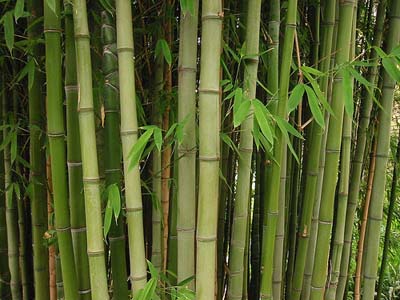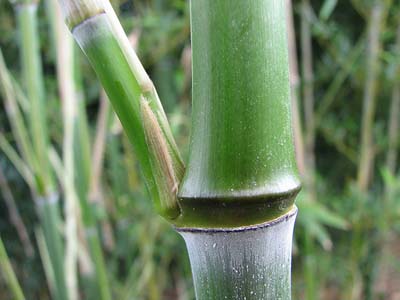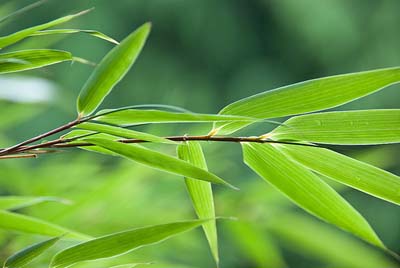Bamboo Plants - A Detailed Explanation
Bamboos are woody stemmed members of the grass family, Poeceae, which belong to the family Bambusoideae. All members of the subfamily can be distinguished from the other grasses by foliage leaf blades which are attached to their branchlets by slender leaf stalks or petioles. Other grasses like corn and sugar cane have leaves without petioles.
The Culms
Like all grasses the bamboos have stems or culms which are segmented by joints called nodes. Bamboo nodes are always solid but between the nodes, the internodes of the culm are usually hollow. A group of culms growing near one another are usually connected together underground by segmented stems called rhizomes to form a single plant. The roots grow from the nodes of the rhizomes. The rhizomes serve as a storehouse of food for the bamboo plant allowing new culms to grow very rapidly. Each culm grows to its full height in a grand period of growth which usually takes no longer than 2 or 3 months. Thereafter, even though it may live for up to 10 years, the culm does not increase in height or diameter. A plant with small rhizomes can produce only small culms. Under favorable conditions the rhizomes will increase in size and produce larger culms each year until the limit for that particular species is reached. The oldest culms are thus often the smallest and the youngest the largest.

Bamboo Culms or Canes
The Rhizomes
There are two basic types of bamboos, the clumpers and the runners. The culms of a clumping species grow close to one another usually no more than a foot apart. while the culms of a runner are often spaced far apart. up to 10 ft. or more. The spacing of the culms is characteristic of each species and depends on the nature of the rhizomes. McClure first used the terms sympodial and monopodial to describe c1umpers and runners. Sympodial refers to the branching habit of clumping rhizomes: each rhizome typically branches into a pair of rhizomes, each of which branches into a pair again. Monopodial refers to the running rhizome which consists of a main axis from which branches arise one at a time. Later (McClure. 1966) the above two terms were abandoned in favor of pachymorph and leptomorph: the first refers to the short. thick shape of the clumping rhizome while the later describes the long, slender shape of a running rhizome. Both pairs of terms describe some of the features of the two rhizome types but I prefer to use the words clumper and runner. A running bamboo has the capability of spreading rapidly. It can also get nourishment from the ground at some distance from its culms. Under favorable growing conditions the runner planted as an ornamental can become a problem, growing into a lawn. a flower bed or a neighbor's yard. The c1umpers are more well behaved as they can only spread slowly from the edge of the clump. In most cases the clump diameter will be no greater than about 10 or 15 ft. after many years. In most genera of bamboos all of the species are either clumpers or runners. Most clumpers are tropical or subtropical plants that are damaged by temperatures below about 15° F, while most runners can withstand colder temperatures. There are exceptions - the two most hardy species grown in the U.S. Thamnocalamlls spathaceolls (Fran.) Soder. and Sinarundinaria nitida (Mitf.) Nakai are clumping bamboos
The Branches
Almost all bamboos have one or more branches that grow from the culm nodes. In many species the lower nodes of large culms remain branchless. The number of branches , their relative size and their arangement on the culm node is an important characteristic for the identification of the genus and sometimes of the species.

Bamboo Branches
The Leaves
The bamboo leaf complement consists of two parts, the sheath and the blade. The sheath wraps around the stem to which it is attached at the sheath base. The opposite or distal end of the sheath develops into the blade which is often flat and bent away from the sheath and stem. Bamboos have two distinct kinds of leaves. Culm leaves and foliage leaves. Culm leaves are attached at the base of their sheaths directly to culm nodes atthe sheath scar. The culm leaf sheath, which is usually large compared to the blade, serves to protect the new culms as they emerge during the grand period of growth. After the culm grows to its full height the culm leaf dries and often fall soff. On the upper end of the sheath on both sides of the blade are two auricles. The bristle-like hairs which extend from the margins of the auricles are called oral setae. Extending up from the central margin of the sheath is the ligule. The auricles and oral setae may be lacking on some species. Culm leaf blades are larger toward the upper end of the culm. Near the upper tip the leaves are similar to foliage leaves; the blades remain green and persist long after the lower culm leaves have fallen off. The culm leaf sheath is often simply called the culm sheath or the sheath. Foliage leaves grow from branchlets. The blades are generally large compared to the sheaths which wrap tightly around the stems often overlapping the sheath above it. The foliage leaf blade is commonly called simply the leaf. Foliage leaves have ligules and often auricles and oral setae. The foliage leaf blade is always attached to its sheath by a stem or petiole in contrast to the culm leaf blade which is often without a petiole. Foliage leaves drop off after about one year but not until new leaves have grown to replace them so that the bamboos are generally green year round. The leaves that grow from main branches tend to resemble culm leaves while those at the ends of culms and branches are somewhere between the two types. To identify species one should look at culm leaves that grow near the middle of large culms and at foliage leaves that grow from branchlets.

Bamboo Leaves
The Flowers
The flowering of bamboo plants occurs at irregular, often long intervals. Each species has its individual pattern; it may flower continuously. yearly. every few years. or at long intervals up to over 100 years. The flowers may be only a few. cover one or a few culms or cover all culms of the species growing in a wide area. With heavy flowering vegetative growth comes to a virtual standstill that may last from a few months to many years, after which the plant may slowly recover its vegetative growth or it may die. Each flower does not produce a seed and often plants will produce a massive quantity of flowers and little or no fruit. The history of the flowering of Phylloslachys is given by Adamson et al. (978) for plants grown at the United States Barbour Lathrop Plant Introduction Garden at Savannah, Georgia (hereafter called the Garden). Eighteen different accessions representing 10 different species flowered between 1951 and 1977. Of these, 8 accessions died, 8 recovered and two were still flowering in 1977. During this time all of the accessions of P. niduaria flowered while some accessions of P. bambusoides flowered and some did not. Because of the rarity of flowering in most bamboos, one must often rely on the vegetative characteristics to distinguish species. When a plant does flower it often lacks the vegetative parts such as culm leaves which are critical for identification. In some cases most of the foliage leaves fall off of flowering plants.
We hope this helped you learn more about bamboo plants
